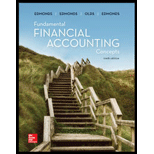
a.
Determine the number of times interest was earned for Company F for Year 3 and Year 2.
a.
Explanation of Solution
Number of times interest is earned: Number of times interest is earned quantifies the number of times the earnings before interest and taxes can pay the interest expense. First, determine the sum of income before income tax and interest expense. Then, divide the sum by interest expense.
Determine the number of times interest earned of Company F for Year 2.
Determine the number of times interest earned of Company F for Year 3.
Hence, the number of times interest earned of Company F for Year 2 and Year 3 is 9.38 times and 9 times respectively.
b.
Compute the earnings per share based on the average number of shares outstanding for Company F for Year 3 and Year 2.
b.
Explanation of Solution
Earnings per Share: Earnings per share help to measure the profitability of a company. Earnings per share are the amount of profit that is allocated to each share of outstanding stock.
Determine the earnings per share of Company F for Year 2.
Determine the earnings per share of Company F for Year 3.
Hence, the earnings per share of Company F for Year 2 and Year 3 are $7.20 per share and $8 per share respectively.
c.
Determine the price earnings ratio for Company F for Year 3 and Year 2.
c.
Explanation of Solution
Price/Earnings Ratio: The price/earnings ratio shows the market value of the amount invested to earn $1 by a company. It is major tool to be used by investors before the decisions related to investments in a company.
Determine the price/earnings ratio of Company F for Year 2.
Determine the price/earnings ratio of Company F for Year 3.
Hence, the price earnings ratio of Company F for Year 2 and Year 3 is 3.33 times and 3.75 times respectively.
d.
Determine the return on equity.
d.
Explanation of Solution
Return on average equity: It is one of the profitability ratios. Return on average equity ratio is used to determine the relationship between the net income available for the common stockholders’ and the average total stockholders’ equtiy. Return on equity is calculated as follows:
Determine the return on average equity of Company F for Year 2.
Determine the average total
Determine the return on average equity of Company F for Year 3.
Determine the average total stockholders’ equity.
Hence, the return on average equity of Company F for Year 2 and Year 3 is 40.00% and 38.78% respectively.
e.
Determine the net margin.
e.
Explanation of Solution
Net profit margin: It is one of the profitability ratios. Profit margin ratio is used to measure the percentage of net income that is being generated per dollar of revenue or sales. It is calculated by using the formula:
Determine the net margin of Company F for Year 2.
Determine the net margin of Company F for Year 2.
Hence, the net margin of Company F for Year 2 and Year 3 is 13.50% and 12.80% respectively.
Want to see more full solutions like this?
Chapter 13 Solutions
Fundamental Financial Accounting Concepts
- TOSHIBA ended the year with an inventory of $842,000. During the year, the firm purchased $5,467,000 of new inventory and the cost of goods sold reported on the income statement was $5,215,000. What was TOSHIBA's inventory at the beginning of the year?arrow_forwardCan you solve this general accounting question with accurate accounting calculations?arrow_forwardOn January 1, 2011, Phoenix Manufacturing purchased for $875,000, equipment having a useful life of eight years and an estimated salvage value of $67,500. Phoenix has recorded monthly depreciation of the equipment on the straight-line method. On December 31, 2018, the equipment was sold for $158,000. As a result of this sale, Phoenix Manufacturing should recognize a gain of___. Help me with thisarrow_forward
- Please provide the solution to this general accounting question using proper accounting principles.arrow_forwardKanye Ridge Industries has a beginning finished goods inventory of $24,300, raw material purchases of $31,500, cost of goods manufactured of $42,700, and an ending finished goods inventory of $18,900. The cost of goods sold for this company is?arrow_forwardGiven the solution and accounting questionarrow_forward
- Helparrow_forwardWhat is the result of this disposal transaction?arrow_forwardStriveTech Co. uses the high-low method to analyze cost behavior. The company observed that at 18,000 machine hours of activity, total maintenance costs averaged $28.00 per hour. When activity increased to 22,000 machine hours (still within the relevant range), the average total cost per machine hour dropped to $25.00. Based on this information, the fixed cost was:arrow_forward

 AccountingAccountingISBN:9781337272094Author:WARREN, Carl S., Reeve, James M., Duchac, Jonathan E.Publisher:Cengage Learning,
AccountingAccountingISBN:9781337272094Author:WARREN, Carl S., Reeve, James M., Duchac, Jonathan E.Publisher:Cengage Learning, Accounting Information SystemsAccountingISBN:9781337619202Author:Hall, James A.Publisher:Cengage Learning,
Accounting Information SystemsAccountingISBN:9781337619202Author:Hall, James A.Publisher:Cengage Learning, Horngren's Cost Accounting: A Managerial Emphasis...AccountingISBN:9780134475585Author:Srikant M. Datar, Madhav V. RajanPublisher:PEARSON
Horngren's Cost Accounting: A Managerial Emphasis...AccountingISBN:9780134475585Author:Srikant M. Datar, Madhav V. RajanPublisher:PEARSON Intermediate AccountingAccountingISBN:9781259722660Author:J. David Spiceland, Mark W. Nelson, Wayne M ThomasPublisher:McGraw-Hill Education
Intermediate AccountingAccountingISBN:9781259722660Author:J. David Spiceland, Mark W. Nelson, Wayne M ThomasPublisher:McGraw-Hill Education Financial and Managerial AccountingAccountingISBN:9781259726705Author:John J Wild, Ken W. Shaw, Barbara Chiappetta Fundamental Accounting PrinciplesPublisher:McGraw-Hill Education
Financial and Managerial AccountingAccountingISBN:9781259726705Author:John J Wild, Ken W. Shaw, Barbara Chiappetta Fundamental Accounting PrinciplesPublisher:McGraw-Hill Education





